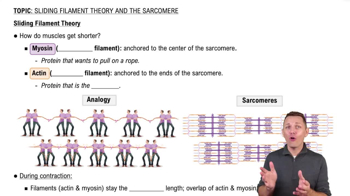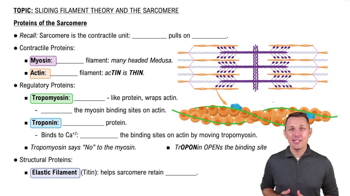Sliding Filament Theory and the Sacromere definitions Flashcards
 Back
BackSliding Filament Theory and the Sacromere definitions
1/15
Terms in this set (15)
- SarcomereThe fundamental unit of muscle contraction, composed of overlapping actin and myosin filaments.
- MyosinA thick filament protein with heads that pull on actin to shorten the sarcomere during contraction.
- ActinA thin filament protein that myosin pulls on to facilitate muscle contraction.
- TropomyosinA thread-like protein that blocks myosin binding sites on actin, regulating muscle contraction.
- TroponinA globular protein that binds calcium, moving tropomyosin to allow myosin-actin interaction.
- TitinAn elastic filament protein that helps the sarcomere return to its original size post-contraction.
- Z-discThe boundary of a sarcomere, anchoring actin filaments and marking the sarcomere's ends.
- M-lineThe central line in a sarcomere that anchors myosin filaments.
- I-bandThe light band in a sarcomere containing only actin filaments.
- A-bandThe dark band in a sarcomere where actin and myosin overlap.
- H-zoneThe central region of the A-band with only myosin, which diminishes during contraction.
- MyofibrilA cylindrical organelle within muscle cells, composed of repeating sarcomeres.
- Sliding Filament TheoryA model explaining muscle contraction by the sliding of actin over myosin, shortening the sarcomere.
- Myosin HeadsProtrusions on myosin filaments that bind to actin and pull it during contraction.
- Sarcoplasmic ReticulumA structure that releases calcium to trigger muscle contraction by interacting with troponin.



